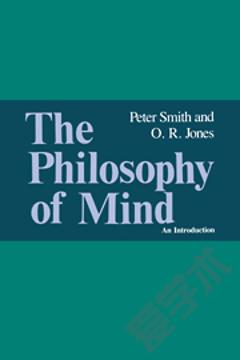Philosophy of Mind —— A Comprehensive Introduction
----- 精神哲学:综合导论
Preface. 1. Mind-Body Theories and Mind-Body Problems. Overview. 1.1 Mind and brain. 1.2 Mind-body theories. 1.3 Mind-body problems. 1.4 The problem of psychophysical emergence. 1.5 The problem of other minds. 1.6 The problem of mental causation. Further reading. 2. The Mental-Physical Distinction. Overview. 2.1 Mental vs. physical. 2.2 Physical phenomena. 2.3 First-person authority and subjectivity. 2.4 Qualia and phenomenal consciousness. 2.5 Intentionality, mental representation, and propositional attitudes. 2.6 Rationality. Further reading. 3. Substance Dualism. Overview. 3.1 Substance dualism: its claims and motivations. 3.2 The argument for substance dualism. 3.3 Objections to the argument for substance dualism. 3.4 Substance dualism and the problem of other minds. 3.5 The problem of interaction. 3.6 Noninteractionist views: parallelism and occasionalism. 3.7 The problem of explanatory impotence. 3.8 Substance dualism in perspective. Further reading. 4. The Physicalist Worldview. Overview. 4.1 What physicalism claims. 4.2 Varieties of physicalism: eliminative, reductive, and nonreductive. 4.3 Implications of physicalist theories. 4.4 Motivations for physicalism. 4.5 The argument for physicalism: past scientific success. 4.6 Hempel s dilemma. 4.7 The knowledge argument. 4.8 Absent and inverted qualia. 4.9 Representational, higher-order, and sensorimotor theories of consciousness. Further reading. 5. Reductive Physicalism. Overview. 5.1 Behaviorism. 5.2 Arguments for and against behaviorism. 5.3 The theory model of psychological discourse. 5.4 The psychophysical identity theory. 5.5 Smart s argument for the identity theory: Ockham s razor. 5.6 Lewis s argument for the identity theory: transitivity of identity. 5.7 Reductivism. 5.8 The multilevel worldview. Further reading. 6. Nonreductive Physicalism. Overview. 6.1 The multiple-realizability argument. 6.2 Reductivist responses to the multiple-realizability argument. 6.3 Functionalism. 6.4 Higher-order properties. 6.5 Functionalism versus the identity theory. 6.6 Functionalism and the nonreductivist consensus: realization physicalism. 6.7 Troubles with functionalism: liberalism and qualia. 6.8 The Chinese room. 6.9 The embodied mind objection to functionalism. 6.10 Kim s trilemma. 6.11 Supervenience physicalism. 6.12 The exclusion argument. 6.13 Nonreductive physicalism in perspective. Further reading. 7. Eliminative Physicalism, Instrumentalism, and Anomalous Monism. Overview. 7.1 The argument for eliminativism. 7.2 The argument against eliminativism. 7.3 Instrumentalism. 7.4 Arguments for and against instrumentalism. 7.5 Anomalous monism. 7.6 The argument for anomalous monism. 7.7 Arguments against anomalous monism. Further reading. 8. Dual-Attribute Theory. Overview. 8.1 Dual-attribute theory vs. physicalism and substance dualism. 8.2 Nonorganismic dual-attribute theories. 8.3 Epiphenomenalism. 8.4 The argument for epiphenomenalism. 8.5 Do qualia exist?. 8.6 Dennett s argument against qualia. 8.7 Wittgenstein s private language argument. 8.8 Arguments against epiphenomenalism. 8.9 Explaining emergence: panpsychism, panprotopsychism, psychophysical laws and structure. 8.10 Emergentism. 8.11 Arguments for and against emergentism. 8.12 Dual-attribute theory in perspective. Further reading. 9. Idealism, Neutral Monism, and Mind-Body Pessimism. Overview. 9.1 Varieties of idealism. 9.2 The motivation and argument for ontological idealism. 9.3 Arguments against idealism. 9.4 Neutral monism . 9.5 The arguments for and against neutral monism. 9.6 Mind-body pessimism. Further reading. 10. The Hylomorphic Worldview. Overview. 10.1 What is hylomorphism?. 10.2 The hylomorphic worldview. 10.3 Organic composition and functional analysis. 10.4 The concept of organization. 10.5 Hylomorphism and the multilevel worldview. 10.6 Hylomorphism vs. physicalism and classic emergentism. 10.7 Causal pluralism. 10.8 The argument for hylomorphism. Further reading. 11. A Hylomorphic Theory of Mind. Overview. 11.1 Patterns of social and environmental interaction. 11.2 Rejecting inner minds. 11.3 Externalism. 11.4 Inner experiences versus sensorimotor exploration. 11.5 Disjunctivism. 11.6 Direct access, pattern recognition, and the problem of other minds. 11.7 Psychological language: pattern expression versus the theory model. 11.8 Hylomorphism versus behaviorism. 11.9 Embodiment. 11.10 Hylomorphism and the mental-physical dichotomy. 11.11 Hylomorphism and the problem of mental causation. 11.12 Hylomorphism and the problem of psychophysical emergence. 11.13 Arguments for and against a hylomorphic theory of mind. Further Reading. 12 Persons [Available online at www.wiley.com/go/jaworski]. 13 Free Will [Available online at www.wiley.com/go/jaworski]. Glossary. References. Acknowledgments. Index.
{{comment.content}}








 京公网安备 11010802027623号
京公网安备 11010802027623号